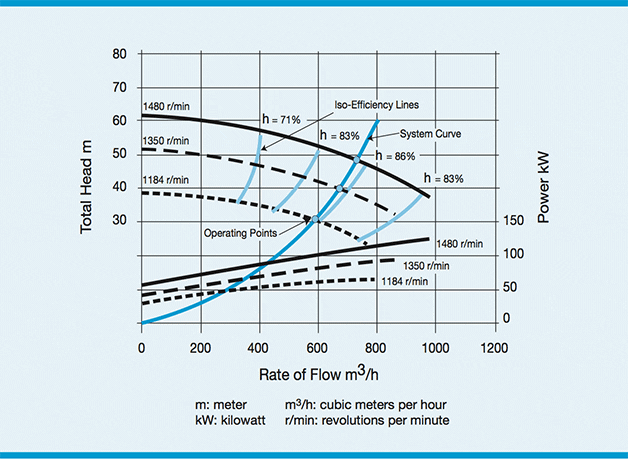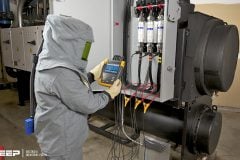Varying the rotational speed
A rotodynamic pump is a dynamic device with the head generated by a rotating impeller. Thus, there is a relationship between impeller peripheral velocity and generated head. Peripheral velocity is directly related to shaft rotational speed, for a fixed impeller diameter.

Varying the rotational speed therefore has a direct effect on the pump’s performance. The equations relating rotodynamic pump performance parameters of flow to speed, and head and power absorbed to speed, are known as the Affinity Laws.
Changing pump impeller diameter also effectively changes the duty point in a given system, and at low cost, but this can be used only for permanent adjustment to the pump curve and is not discussed further as a control method.
Proper selection of pumps, motors, and controls to meet the process requirements is essential to ensure that a pumping system operates effectively, reliably, and efficiently.
For systems where friction loss predominates, reducing pump speed moves the intersection point on the system curve along a line of constant efficiency (Figure 1).
The operating point of the pump, relative to its best efficiency point, remains constant and the pump continues to operate in its ideal region. The Affinity Laws are obeyed, which means that there is a substantial reduction in power absorbed accompanying the reduction in flow and head, making variable speed the ideal control method.

However, in systems with high static head, the system curve does not start from the origin but at some non-zero value on the y-axis corresponding to the static head. Hence, the system curve does not follow the curves of constant efficiency. Instead, it intersects them (see Figure 2).
The reduction in flow is no longer proportional to speed; a small turn down in speed greatly reduces flow rate and pump efficiency. A common mistake is to also use the Affinity Laws to calculate energy savings in systems with static head.
Although this may be done as an approximation, it can also lead to major errors.

It is relevant to note that flow control by speed regulation is always more efficient than by a control valve. In addition to energy savings, there could be other benefits to lower speed.
The hydraulic forces on the impeller, created by the pressure profile inside the pump casing, reduce approximately with the square of speed. These forces are carried by the pump bearings, and so reducing speed increases bearing life. It can be shown that for a rotodynamic pump, bearing life is proportional to the seventh power of speed.
In addition, vibration and noise are reduced and seal life is increased, provided that the duty point remains within the allowable operating range.
Reference: Variable Speed Pumping — A Guide to Successful Applications, Executive Summary (Hydraulic Institute, Europump, and the U.S. Department of Energy’s (DOE) Industrial Technologies Program)











So if we increase the speed by a factor 10, we can get 10 Million years out of a set of bearings, designed to last only one year?